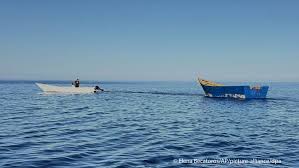Irregular EU entries down as new routes emerge

Brussels: As many migrant routes into Europe are effectively being shut down by increased surveillance and interceptions, other routes are gaining in popularity — as smugglers continue to cash in on desperate migrants hoping to reach the EU. The routes from Libya to Crete and from Algeria to the Balearic Islands are two examples.
Overall, irregular migrant arrivals into the European Union have been steadily declining since 2024; last year, only 240,000 people successfully made irregular journeys to Europe, marking a decline of about 60,000 compared to the previous year.
In the first six months of 2025, a further drop of roughly 20 percent is being observed; however, this does not mean that every irregular route into the bloc is equally affected.
Some corridors into the EU are even seeing increased migrant traffic, while new routes are emerging at the same time in response to existing routes being monitored and controlled more closely.
Although the overall number of irregular migrants successfully making their way to Europe has fallen, many migrants and their smugglers continue to find new — and oftentimes more dangerous — routes to take people to the continent.
Stricter measures at all EU borders introduced progressively in recent years may have contributed to this downward trend, which was first observed last year.
The EU has also spent billions on boosting the activity of EU border agency Frontex and its staff at both its external and internal borders over the past decade since the onset of the so-called “refugee crisis” of 2015 and 2016.
According to Frontex itself, the drop in arrivals is also directly related to increased EU cooperation with known transit countries, especially in North and West Africa.
Helena Hahn from the European Policy Centre think tank shares the Frontex view that deals with transit countries in Africa are a big part of the reason why numbers are going down.
She said that “(c)ooperation with North African countries has certainly played a role in reducing arrivals.”
The EU has in recent years reached deals with the governments of Libya, Tunisia, Egypt, Algeria, Mauritania and other nations to intervene in attempted crossings into EU territory.
In most instances, this means that the bloc offers money to the respective government to help prevent illegal crossings.
With such agreements also typically involving better surveillance and added patrolling capacities, people smugglers continue to look out for new routes, hoping to catch authorities off guard.
The IOM meanwhile stresses that these partnerships also result in other routes gaining in popularity.
One of the routes that has emerged as a growing trend in 2025 is the journey from Libya to the southern Greek island of Crete.
Over 7,000 people have reached what is the largest of all Greek islands using this route this year alone, prompting the Greek government to take emergency measures in response.
These include a temporary ban on processing asylum applications of new arrivals and the tabling of new laws in Athens, which would further criminalize unauthorized entry into Greek territory.
In the past, the vast majority of irregular departures to Europe from Libya and neighboring countries like Egypt and Tunisia aimed for Italy and, in some instances, Malta.
However, after a series of new laws were introduced in Rome, many smugglers operating in North Africa adapted their business model, diverting their boats to Crete instead; this involves a longer and far more perilous journey at sea.
In fact, migrant arrivals in the EU across the Central Mediterranean route to Italy and Malta decreased by nearly 60 percent from 2023 to 2024, which the IOM directly links to higher rates of interceptions at sea and migrant returns to countries of departure such as Libya and Algeria.
Another route that witnessed a rise is the so-called Balearic route from North Africa to Spain’s archipelago in the Mediterranean.
A growing number of migrants are opting to head for the Balearic Islands in the Mediterranean, especially from the coast of Algeria.
According to the UNHCR, nearly 3,500 (3,431) migrants had made their way to the island group in the Mediterranean on a total of 182 boats from Algeria, landing mainly on the Balearic islands of Ibiza and Mallorca, since the beginning of the year.
UNHCR added that this marks an increase of 124 percent compared to 2024.
The journey to the Balearic Islands is much shorter than the Atlantic route to Spain’s Canary Islands, but not necessarily safer because of this.
Other routes into the European Union meanwhile have by-and-large reached a manageable level of consistency and predictability after years of EU intervention.
For example, the number of boat arrivals on Greek Islands in the Aegean Sea from the Turkish coast has fallen and stabilized in recent years, as have crossings over the Greek-Turkish land border.
This is in great part due to a 2016 deal between the EU and Turkey, in which the Turkish government received 6 billion euros in exchange for helping to stop irregular journeys into the EU and taking care of millions of Syrian nationals who had fled their country during the 14-year civil war under former strongman Bashar Assad.
The Western Balkan route used by migrants to reach parts of Western Europe via Balkan states such as Serbia, Bosnia and Herzegovina, and Croatia has also witnessed a steep fall in irregular migration. Crossings into Europe since 2023, with Frontex reporting a drop of 78 percent.
Those numbers, however, might be skewed, as various charities have recorded a less dramatic decline on the Balkan route in particular.
The global NGO International Rescue Committee (IRC) said that it detected a drop of only 16 percent over the same period.
The organization suggests that this is proof that migrant smugglers are operating more covertly and at least partly succeeding in their bid to avoid detection; this also means that migrants are often having to pay higher fees to smugglers, making the criminal business of people smuggling in some cases even more lucrative.
“There’s a lot of deterrence, but it just makes people take more dangerous routes,” said Martha Roussou, a senior advocacy advisor at the IRC.
Jennifer Vallentine, an expert working for migrant research institute the Mixed Migration Centre, highlighted that such changes in migrant routes are part of a typical pattern that appears whenever governments try to legally restrict irregular migration.
“As one route declines, others usually surge or re-emerge,” she said, adding that “(h)arsh restrictions won’t stop the need and desire to migrate, and with irregular migration the only option for some, smuggler services will stay in demand.”
The EU meanwhile remains steadfast in its commitment to fight migration while continuing on the same policies; the bloc announced plans to triple its spending on its borders in its upcoming Multiannual Financial Framework for the years 2028 to 2034.
The total amount intended to be spent on Europe’s borders during this period will be about 81 billion euros — an amount that is equal to the GDP of Peru.
Whether this course will prove to be a success in the long run is uncertain; experts like Vallentine disagree with such methods:
“(Europe’s) reactive approach fails to acknowledge migration as both inevitable and beneficial,” she said.
“Until regular and accessible pathways are established, we will continue to see irregular migration — and smuggling networks will continue to adapt to facilitate it.”
Other experts also warn that irregular migration to the EU will continue as armed conflicts and growing global inequality keep pushing people to seek out new pathways out of their desperation, even if it means taking higher risks.





